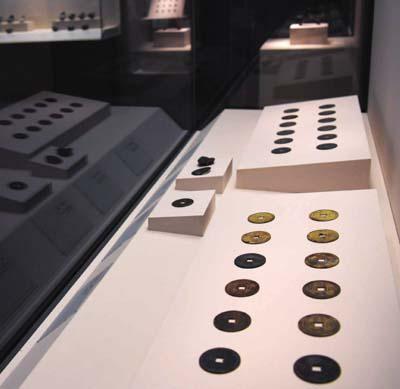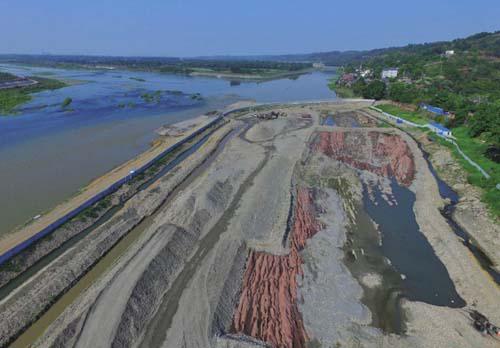Unearthing a Legend
2018-07-30ByJiJing
By Ji Jing


Legend has it that almost 400 years ago, a peasant rebel troop leader intentionally hid a large treasure at the bottom of the Minjiang River in Jiangkou Town, southwest Chinas Sichuan Province.
Recently, the legend was proved to be real by a tremendous archaeological discovery.
A history or a legend?
Zhang Xianzhong (1606-47), who commanded a peasant uprising in 1630 during the late Ming Dynasty (1368-1644), captured Chengdu (capital of Sichuan) and founded the Daxi Kingdom (Kingdom in the Great West) in 1644. But he was forced to flee the city two years later and was defeated in a battle by a Ming Dynasty general in Jiangkou. His fleet of 1,000 vessels sank to the bottom of the river during the battle and Zhang was killed by Qing Dynasty (1644-1911) troops in 1647.
A legend thereafter was passed from generation to generation that Zhang had hidden a large treasure in wooden scabbards at the bottom of the Minjiang River in Jiangkou for a future comeback. There was even a riddle which described the possible location of the sunken treasure.
However, since there have never been any verifiable historical records, controversy has abounded as to whether there really was a sunken treasure in the river and if so, where it was hidden. Rumors continued to grow in the 1920s, when important cultural relics began to occasionally be discovered in the Jiangkou section of the Minjiang River. In 2015, Meishan Municipal Police solved several cases involving the theft and trading of treasures dug out of the river, recovering over 1,000 artifacts worth 300 million yuan ($45.2 million).The cases prompted the Sichuan Provincial Cultural Relics and Archaeology Research Institute and the National Center of Underwater Cultural Heritage to apply to excavate around the Jiangkou site in January 2016. The State Administration of Cultural Heritage approved the application in April of the same year.
However, out of consideration for safety and costs, the excavation was only begun dur- ing the dry season from December to the end of April the following year.
Treasure discovered
Over 42,000 artifacts have been unearthed so far by two excavations in 2017 and 2018, including gold and silver bowls, coins, jewelry, silver ingots and weapons. Over 500 of the artifacts were selected for an exhibition at the National Museum of China in Beijing which de- buted on June 26. The excavation has not only provided evidence of the authenticity of the legend but has also shed light on the politics, military activities and social life of the middle and late Ming Dynasty. It was listed as one of the Top 10 Archaeological Finds in China in 2017.

In total, over 1,000 artifacts were found directly related to the Daxi Kingdom, which had few historical records before the find. Liu Zhiyan, co-leader of the excavation project and Director of the Underwater Excavation Center of the Cultural Relics Institute, said the artifacts provided material evidence about the governance of the Daxi Kingdom.
“The silver ingots with a year, weight, usage and tax name reveal the fi scal and taxation system of the Daxi Kingdom, and gold and silver coins conferred on victorious military officers under Zhangs command reflect the military reward system of the Daxi,” Liu said.
He also explained that many stories tend to demonize Zhang, equating him with a ruthless killer who cared nothing about his regime. However, the artifacts unearthed may help correct this impression since they reveal that Zhang established offi cial selection and reward systems, as well as a fi scal system after founding the Daxi Kingdom.
At the exhibit in Beijing, a number of iron weapons are on display, proving the excavation site was where the actual Jiangkou battle took place. It is also worth noting that the wooden scabbard which is part of the exhibition proves the legend that Zhang used wood to store silver. It is said that he cut a piece of wood into two halves, carved both halves hollow and stored silver inside before using iron or copper to seal the wood.
In addition, over 150 silver ingots bearing place names from central to south China including Henan, Jiangxi, Guangxi and Guangdong provide clues to Zhangs military itinerary.
Exquisite gold and silver accessories such as earrings, bracelets and rings are showcased, which refl ect the aesthetics of the middle and late Ming Dynasty.
Moreover, according to Liu, inscriptions on gold pieces that conferred titles on Zhangs concubines provide evidence of a harem system during the Daxi Kingdom.
Innovative methods
To conduct the excavation, archaeologists identified an area of 20,000 square meters in Jiangkou based on local residentsaccounts and occasional discoveries of relics during the construction of engineering projects in the river in recent years. They also cooperated with local police to question thieves about where they had found their loot.
Since this marked the fi rst underwater excavation in Sichuan, the next problem to solve was how to go about digging out the artifacts.
Diving is the traditional way to carry out underwater archaeological discoveries. But Zhou Chunshui, Associate Researcher of the National Center of Underwater Cultural Heritage, said, it was not feasible to use this method given that the muddy waters of the Minjiang River make it impossible for divers to see anything. Another shortcoming with diving was the amount of oxygen and physical strength required to excavate since divers can only last a limited amount of time. The rivers fast water fl ow also posed a danger to the safety of the divers.
After multiple inspections of the site, archaeologists decided to build dams using sand and stones around the designated area and pump the water out to turn the river into land. The area will be refi lled with water after the excavation is completed.
According to Gao Dalun, President of the Sichuan Cultural Relics and Archaeology Research Institute, there are over 100 people engaged in the excavation. Excavators and screening machines have been employed and spot checks are conducted to avoid the missing of artifacts.
Once something is discovered, an advanced positioning technology called real-time kinematic positioning is employed to record the exact position of the artifact in the water.
“For archaeologists, its not important what we find but how much information we can derive from the artifacts we fi nd. We found two areas with the most concentrated artifacts, which may indicate there were two ships sunk there, providing great clues for fi nding the battle site,” Liu said.
According to Gao, it is estimated that the Jiangkou archaeological site covers an area of approximately 1 million square meters, well over the excavations 20,000 square meters.
“We may have found the core area, we may still be at the periphery of the core area, but it is more likely the actual area of the site is far larger than our estimates,” said Gao. “In the future, we will continue our excavation until we get a clear understanding of the layout and signifi cance of the site.”
Subsequently, a museum will be built along the Minjiang River which will host all the over 42,000 relics unearthed. “We will not dig all the artifacts out because we want to preserve them and leave them for future generations,” said Gao.
